MOX, Recycling Nuclear Energy
.jpg?sfvrsn=bd059331_6)
All about MOX
MOX today
At the end of the 1960s, the French nuclear industry began asking itself about the reprocessing of used fuel. Processes had been developed that could recycle 96% of the fuel by sorting its different components.
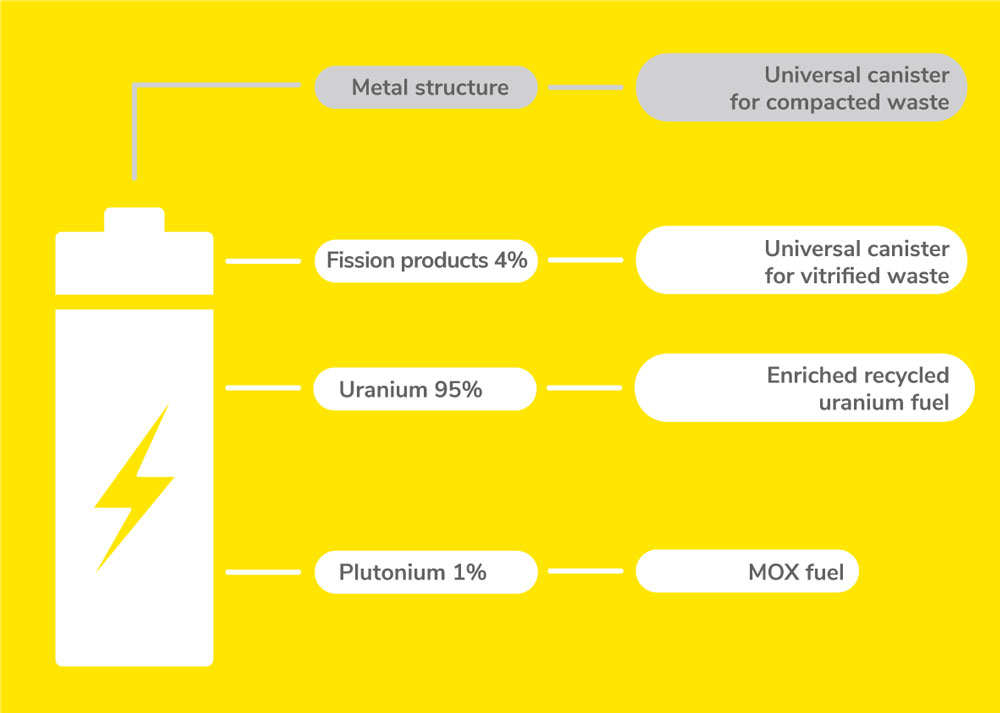
44 nuclear reactors have used MOX fuel since 1972, including:
- 22 in France
- 10 in Germany
- 5 in Japan
- 3 in Switzerland
- 2 in Belgium
- 1 in the Netherlands
- 1 in the United States
“MOX offers a response to today’s issues. It is in line with our society’s demand for maximum recycling of resources. France asked itself the question as early as the 1960s. With this approach, we can produce one recycled uranium fuel and one MOX fuel from eight used fuel assemblies. That’s a significant savings of raw materials!"
Jean-Philippe Madeleine, Melox plant Director
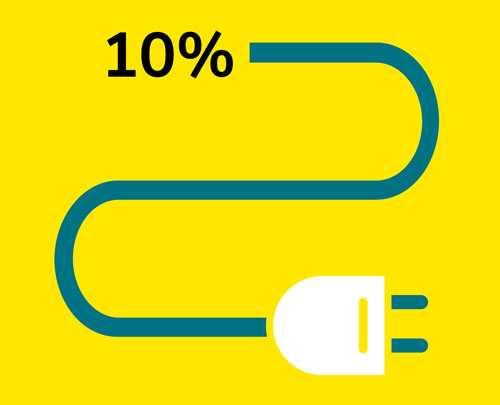
Currently, Orano is the only company to produce MOX fuel assemblies, which it does at the Melox plant. Opened in 1995, the plant produces enough MOX fuel each year to supply 25 to 30 reactors as a supplement to enriched uranium fuels. Its production capacity has just been increased with the installation of a second powder mixing line, the first stage in MOX fabrication. This new equipment facilitates the production of mixtures meeting the specifications of various customers, providing additional guarantees of on-time delivery.

Stages of MOX fabrication
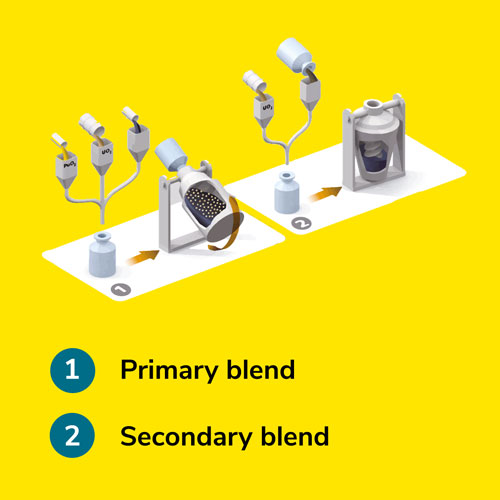
Stage 1: Powder blending
The primary blend is made by mixing powders of plutonium oxide, depleted uranium oxide and chamotte (pellet scrap). At this stage, it is slightly less than 30% plutonium. Depleted uranium is added to this mixture to obtain a plutonium content of 3% to 12%, depending on the customer’s requirements. This plutonium mixture corresponds to the settings of the reactor in which the MOX fuel will be used.
Stage 2: Pellet fabrication
The resulting mixture is compacted into the shape of pellets that are fired in a high-temperature furnace, which converts them into a ceramic. This is known as sintering. The pellets are ground between two grinding wheels to the required diameter to the nearest micron. Out-of-spec pellets are returned to the head end of the process to be recycled as chamotte.
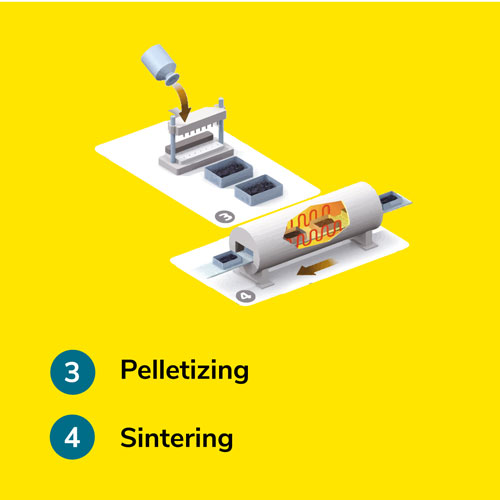
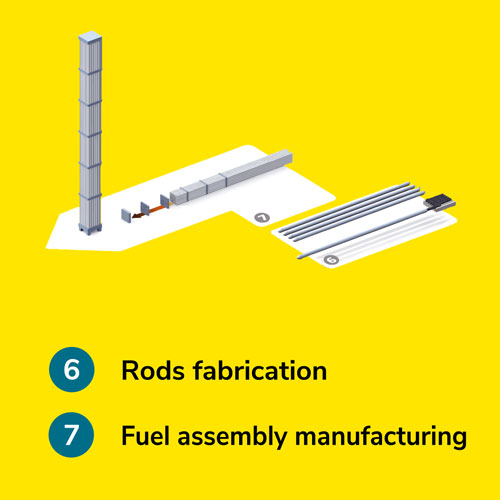
Stage 3: From the pellet to the assembly
The pellets are inserted into tubes made of zirconium alloy called “fuel rods”. Each fuel rod is approximately 4 meters long and consists of about 320 pellets; the actual number varies according to the customers’ requirements. After
this, the fuel rods are carefully cleaned and inspected.

Why choose MOX?
The advantages of MOX

“ The amount of plutonium inventories generated by operating reactors is a very serious matter for utilities. By choosing MOX, they are not postponing this issue to tomorrow, since they can consume as much plutonium as their reactors produce today, keeping plutonium inventories in balance. Not using MOX is the equivalent of opting for a long-term plutonium repository, with growing volumes, and leaving its management to future generations. “
Jean-Philippe Madeleine, Melox plant Director
MOX responds to its detractors
The arguments of MOX detractors have not changed very much since the early days of this fuel from recycling: it is seen as too toxic and too expensive to produce, and the fact that it contains plutonium is viewed as presenting risks of diversion for defense applications. For Jean-Philippe Madeleine, Melox plant Director, this criticism is unjustified.
“ The risks related to plutonium handling call for particularly demanding precautionary measures to ensure its containment. They were factored into the design of the Melox plant. Between Cadarache and Melox plants, we now have 25 years of experience in handling plutonium with no major incidents.
The cost-effectiveness of MOX is an eternal debate that largely depends on the point of view one takes. MOX production has a cost, but it’s worth noting that the utility that uses it the most, EDF in France, produces the cheapest electricity in Europe.
MOX makes it possible to keep plutonium inventories in balance, and thus provides more solutions than problems in terms of proliferation. ”
MOX to manage defense plutonium in the United States
Following the disarmament agreements signed with Russia, the U.S. authorities agreed to demilitarize 34 tons of defense plutonium. It was decided to develop a special MOX facility to recycle it into civilian fuel for commercial power production.
The plutonium will ultimately be processed in the MFFF (MOX Fuel Fabrication Facility), a project begun in 2007 in Savannah River, South Carolina, a historical nuclear site which has been reconverted into recycling operations in recent years.
The Americans have called on Orano’s technology for this project. In addition to giving technical advice based on its operating experience at the la Hague and Melox sites, Orano will provide training
to a hundred workers from the MFFF.
What is the global outlook for MOX?
MOX is a recycled fuel that recovers the plutonium contained in used fuel. Far from being limited to France, it is currently the focus of a number of important projects around the world.
MOX in Europe
MOX continues to be widely used in Europe. While Germany has abandoned it, along with all of its nuclear power production, EDF continues to use it in more than 20 reactors of the French fleet. The Netherlands has also chosen MOX for its sole reactor.At the Sellafield site in the United Kingdom, the British government must find a recycling solution for 140 tons of plutonium from used fuel. To meet this requirement while ensuring nuclear fuel supplies, in 2011 the British government determined that plutonium recycling in MOX was “the most credible and technologically the most mature option”. ORANO’s Convert project provides the British authorities with a comprehensive solution for nuclear fuel management. It is based on the construction and operation
MOX in Asia
Japan will continue to use MOX :The Federation of Electric Power Companies of Japan, confirmed that 16 of the 18 nuclear reactors in the national fleet would continue to use MOX fuel after their restart. In 2017, Orano delivered MOX fuel assemblies to Kansai Takahama nuclear power plant. At the same time, Orano signed a contract with Japan's NFI (Nuclear Fuel Industries) for the fabrication of 32 MOX fuel assemblies for the Kansai Takahama reactors.
As a long-standing supplier to Japan, Orano is participating with Japan Nuclear Fuel Ltd. in the construction of a MOX fabrication plant in that country called J-MOX. For the technology, it is largely inspired by the Orano Melox plant, the global leader in MOX production, and regularly benefits from the French site’s operating experience. Orano is also providing training for future J-MOX specialists. This plant is located at the Rokkasho-Mura site in the northernmost part of Honshu Island. It will have an estimated production capacity of 130 metric tons of MOX fuel per year.
MOX, a solution for China ?
“ China is on track to become the world’s leading nuclear power, with more than 40 reactors currently under construction or on order. It is therefore looking at the recycling question very closely, in collaboration with France. The use of MOX also appears to be a logical answer to the growing demand for fuel from its nuclear fleet. The project in China is very important for us, because it shows that used fuel recycling is an essential question, and it validates our know-how in this field.“
Pascal Aubret, Orano Recycling Business Unit Director
“ The volume of engineering hours and the amount for the purchase of all types of equipment make the future Chinese plant a very ambitious project, with much at stake financially for Orano. In addition, based on the Chinese reactor construction program, one plant will not be enough. Very quickly, other facilities will be necessary. “
Jean-Pierre Gros, Orano Director of the Chinese Recycling Proposal
MOX tomorrow
MOX thus allows countries who have opted for nuclear power to manage their plutonium inventories and to supply a growing number of reactors. All third generation reactors, such as the EPR model, can use it. Longer term, the fourth generation of reactors currently in the design phase, based on the fast neutron concept, can make optimum use of the plutonium. This would require a suitable fuel derived from MOX concepts." We are currently in a position to fabricate MOX fuel assemblies suited to most reactors presently in service or under construction. So, in the coming years, using MOX or not using it will be an important question for utilities around the world. It’s up to us to convince them of the advantages of using it! "
Pascal Aubret, Orano Recycling Business Unit Director
